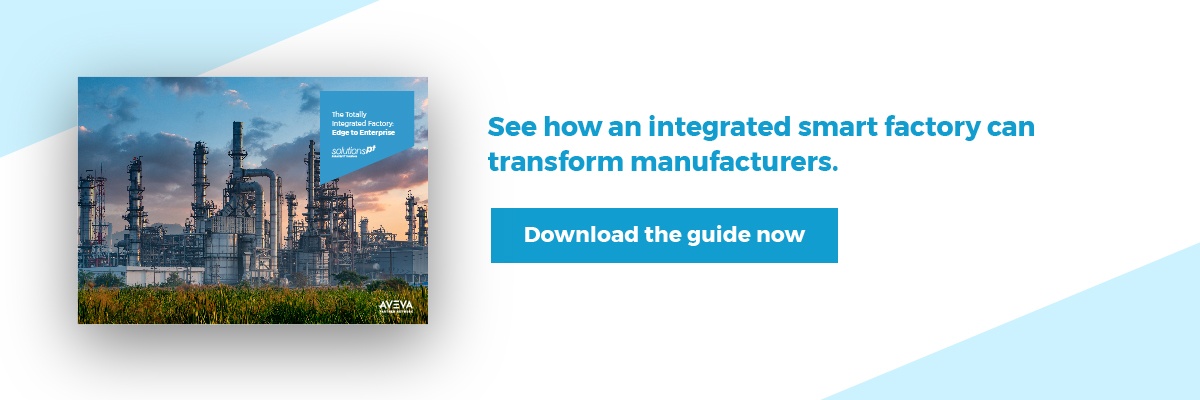When the term ‘factory of the future’ is used, it all sounds a bit science-fiction. Flying cars, robots, colonies on Mars - something that’s on the horizon but not really worth thinking about right now.
.jpeg?width=600&name=lenny-kuhne-jHZ70nRk7Ns-unsplash%20(1).jpeg)
What is a Factory of the Future?
The reality is ‘smart factories’ aren’t from the world of tomorrow, they’re possible now as part of the Industrial 4.0 revolution. Some manufacturers are already transforming their factories to give them an edge on their competition. Here’s what that looks like.
Cutting-Edge Smart Manufacturing Systems
Sorting Data With AI
The manufacturing industry is seeing the gradual coming together of IT and OT as well as the rise of Industry 4.0. The factory of the future represents a shift from more traditional automation to a fully connected and flexible system. This change has come about, in part because data is now recognised as an asset.
With every device and machine collecting valuable data, manufacturers can harness it to inform business decisions and provide unique insight into operations. Only with this true visibility can you identify issues that are preventing growth and harming profits.
Getting the most from this ever-growing mountain of data isn’t easy. It’s already incredibly difficult for a human to sift through it all to determine what’s relevant. The sheer volume of information means it’s hard for any human to understand possible data patterns and identify the best course of action. This is where smart factories will employ AI solutions to identify crucial patterns and issues quickly and effectively.
Fewer Errors and a Safer Place to Work
No matter the size or scale of a factory, the fewer errors that take place and the smoother the manufacturing process is, the easier it is for a business to grow. The factory of the future will drastically reduce errors through full automation.
This isn’t the traditional automation that many of us are used to. It’s a shift towards a fully connected and flexible system which uses a constant stream of data to learn and adapt to bespoke requests.
Automated systems and intelligent software remove human errors, but that doesn’t mean they replace human workers. In fact, this automation simply elevates the capabilities of factory staff. Plus, the factories themselves will be a much safer place to work thanks to automated safety protocols.
Less manual work will be needed, but when it is, it can be carried out quickly and safely thanks to technologies like safety light barriers and vision detection systems. Smart cameras can not only keep workers safer but also improve product quality by providing accurate, automated control and feedback.
Greater Connectivity to Suit the User
The ‘Connected Worker’ is a concept we’ve touched on in the past. It’s the idea that workers on the plant floor can easily connect to others back in the control room. Both parties would be able to access the same information required to carry out their tasks without wasting time, energy or resources.
The information the two sets of workers need would be augmented to suit their specific responsibility. The same data, just presented in the most effective way depending on the device and task of the person accessing it.
It might be that the plant worker who’s taking a closer look at a faulty piece of equipment wants a second opinion. In the factory of the future, a third-party could dial in to help identify the problem through “over-the-shoulder” technology. This allows for access to experts wherever you are because everyone cannot be experts in all areas. Issues are then resolved quickly and without any unnecessary back and forth between teams.
Again, the term factory of the future is slightly misleading - this is possible right now.
Decision-Making Backed by Predictive Analytics
Machines break and, in the past, there wasn’t much we could do about that. Teams would have to think on their feet to fix the machine as quickly as they could to avoid too much downtime, which would affect production levels.
Unplanned outages can be costly but smart factories don’t have this problem thanks to predictive maintenance analytics which is powered by machine learning. With it, we can know when a machine is going to experience an outage and schedule maintenance instead.
This information can shape business decisions. For example, if our analytics model which is powered by artificial intelligence tells us the machine will take a couple of days to sort, you can divert production to another line or site to ensure you still meet your targets.
Real-time information allows you to take action and ensure equipment faults don’t halt production. Plus, this data can be harnessed to notify the relevant people when a line is consuming more materials than usual. Whatever the reason, the anomaly can be investigated before it’s allowed to escalate.
Smart factories aren’t science-fiction. With the right systems, products and culture, today’s factories can transform to become fully integrated. This gives managers full transparency into what’s happening across teams and ensures the whole production process, from beginning to end, is as efficient and profitable as possible.
For a more visual look at how your factory could benefit from greater connectivity and integration, make sure to download our free guide.
A Totally Integrated Factory
The guide features a detailed illustration that shows how asset location, across enterprise and the control room, can coordinate and collaborate for the benefit of your business.
Download your copy now using the link below to see how connected factory systems and digital transformations can empower your people and lead to success.
 If you'd like to see it in action, simply request a demo below.
If you'd like to see it in action, simply request a demo below.

![[FREE GUIDE] EMBRACING NEW TECHNOLOGY TO TRANSFORM YOUR FACTORY](https://no-cache.hubspot.com/cta/default/4487147/9d21f2d1-3cef-4512-b927-eb448cf098a0.png)

